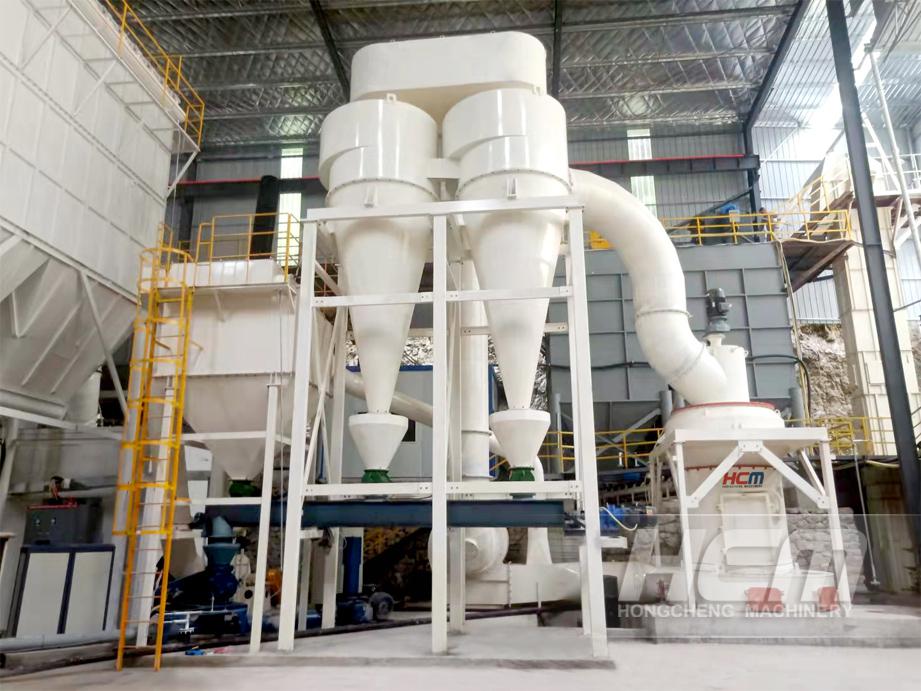Vanadium nitride is a composite alloy containing vanadium, nitrogen and carbon. It is an excellent steelmaking additive. By refining grains and precipitation strengthening, FeV nitride can greatly improve the strength and toughness of steel; The steel bar added with FeV nitride has the characteristics of low cost, stable performance, small strength fluctuation, cold bending, excellent welding performance and basically no aging. In the production process of vanadium nitride, the vanadium nitrogen grinding mill process is an important step, which is mainly realized through the vanadium nitrogen Raymond mill. As the manufacturer of vanadium nitrogen Raymond mill, HCM will introduce the application of vanadium nitrogen grinding mill process in the production of vanadium nitride.
Vanadium nitride production process:
(1) Main raw and auxiliary materials
① Main raw materials: vanadium oxides such as V2O3 or V2O5.
② Auxiliary material: reducing agent powder.
(2) Process flow
① Workshop composition
The vanadium nitrogen alloy production line is mainly composed of raw material grinding room, raw material preparation room (including batching, dry and wet mixing), raw material drying room (including ball pressing drying) and TBY kiln room.
② Main equipment selection
Pendulum vanadium nitrogen grinding mill: two 2R2714 type mills, with a capacity of about 10t/d · set. The main motor power of the equipment is 18.5 kW. The load rate of the mill equipment is 90%, and the operation rate is 82%.
Mixer: 2 rotary dry mixers with a capacity of 9 t/d. The equipment load rate is 78%, and the operation rate is 82%.
Wet mixer: one XLH-1000 planetary wheel mill mixer (with a capacity of about 7.5 t/d) and one XLH-1600 planetary wheel mill mixer (with a capacity of about 11 t/d). The total load rate of the equipment is 100% and the operation rate is 82%.
Forming equipment: 6 sets of powerful pressure balls are used, and the forming capacity of a single set is 3.5 t/d. The equipment load rate is 85.7%, and the operation rate is 82%.
Drying equipment: 2 tunnel type two hole drying kilns with working temperature of 150~180 ℃.
③ Process flow
S1. Grind the solid vanadium oxide and activated carbon blocks with a vanadium nitrogen Raymond mill, and remove impurities from vanadium oxide and activated carbon particles with an electrostatic precipitator to obtain vanadium oxide particles and activated carbon particles; In step S1, the particle size of vanadium oxide particles and activated carbon particles is ≤ 200 meshes, and the total area of particles per gram of weight is not less than 800 square meters; S2. Weigh vanadium oxide particles, activated carbon particles and adhesives; S3. Fully mix the vanadium oxide particles, activated carbon particles and binder after weighing and proportioning with a mixer; S4. The mixture of vanadium oxide particles, activated carbon particles and binder is pressed with a hydraulic press to obtain a blank with uniform shape and specification; S5. Spot check the blank to ensure that the size error of the blank is within the designed size error range; S6. Put the flaky billets into the vacuum furnace orderly, vacuum the vacuum furnace and raise the temperature to 300-500 ℃, and preheat the billets under vacuum conditions; In step S6, vacuum the vacuum furnace to 50-275P a, and preheat the temperature in the furnace to 300 to 500 ℃ for 40-60 minutes; S7. After preheating, open the nitrogen gas supply equipment to feed nitrogen into the vacuum furnace, so as to make the furnace transition from negative pressure to positive pressure, maintain the positive pressure of nitrogen, and make the temperature in the vacuum furnace rise to 700-1200 ℃. The billet first undergoes carbonization reaction under the catalysis of active carbon, and then nitrides with nitrogen; S8. After the heating time is reached, stop heating, keep nitrogen supply and open the pressure relief valve to make the furnace pass through nitrogen gas flow, so that the billets can be rapidly cooled. When the billets are cooled to below 500 ℃, open the vacuum furnace, take out the billets and transfer them to the cooling storage bin, and then obtain vanadium nitrogen alloy products after the billets are naturally cooled to room temperature; S9. Wrap the finished vanadium nitrogen alloy with plastic film for finished product protection and send it to the warehouse.
Vanadium nitrogen grinding mill process is mainly applied to the grinding of vanadium nitride raw materials. This step is mainly completed by vanadium nitrogen Raymond mill. The technological process is as follows: vanadium oxide and catalyst raw materials are sent to the host through the feeding mechanism (vibration/belt/screw feeder or air lock feeder, etc.); The high-speed rotating grinding roller tightly rolls on the grinding ring under the action of centrifugal force. The materials are shoveled by the blade to the grinding area formed by the grinding roller and the grinding ring. The materials are broken into powder under the action of the grinding pressure; Under the action of the fan, the materials milled into powder are blown through the separator, and those meeting the fineness requirements pass through the separator, while those failing to meet the requirements are stopped by the separator and returned to the grinding chamber for further grinding.
The HC1000 and HCQ1290 Vanadium nitrogen Raymond mill produced by HCMilling(Guilin Hongcheng) are upgraded and improved Vanadium nitrogen Raymond mill based on the traditional 2R Raymond mill. It has the advantages of high output, stable operation and long service life of wearing parts. If you need a vanadium nitrogen grinding mill, please contact us for details and provide follow information to us:
Raw material name
Product fineness(mesh/μm)
capacity (t/h)
Post time: Nov-30-2022









